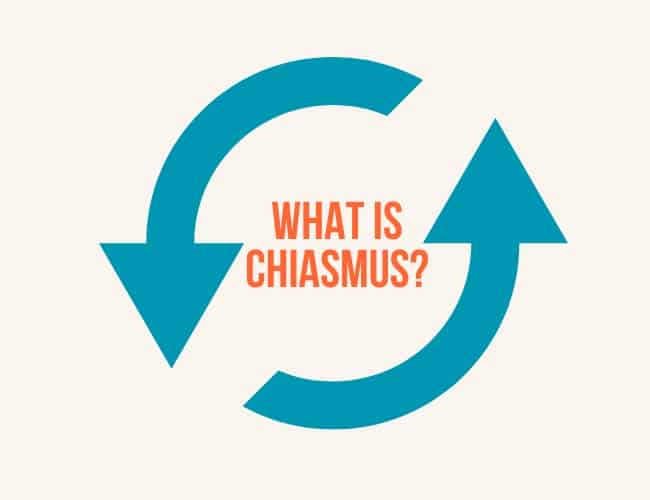When I was a kid and wanted something that we didn't have, my father would tell me, “If we had some eggs, we could have ham and eggs if we had ham.” As an adult, I appreciate the ironic humor in this statement as well as its literary form, which is chiasmus. But what is chiasmus? Let's find out.

What is chiasmus? A definition
According to Merriam-Webster Online, chiasmus is “an inverted relationship between the syntactic elements of parallel phrases (as in Goldsmith's to stop too fearful, and too faint to go).”
I don't know about you, but that definition doesn't help me much until I break it down. Let's start at the back.
Parallel phrases: Parallelism is when two elements (in this case, phrases) of a sentence have the same grammatical structure. The figure of speech is even more powerful when the ideas and themes are repeated.
Ancient Hebrew and Middle Eastern poetry used parallelism and its chief organizing principle. Parallelism is a fascinating subject in itself, so we will settle for a single example. Psalm 24:1–2 provides us with an instance of clear parallelism:
The earth is the Lord's and all that fills it
the world and those who dwell therein,
for he has founded it upon the seas
and established it upon the rivers.
Syntactic elements: Syntax is the arrangement of words and phrases in a sentence. So the elements of syntax are nouns, verbs, adjectives, adverbs, pronouns, etc. In the example from Psalm 24, we can see how the words in the parallel phrases come in the same order: earth/world (nouns with similar meanings); and all that/and those who (connecting phrase); fills it/dwell therein (verb and complement).
Inverted relationship: This simply means that the second phrase's elements come in reverse order. We see that in the example from Webster: to stop (verb) too fearful (adjective) / too faint (adjective) to go (verb).
Another example comes from Psalm 145:2.
Every day I will bless you (Adverb of time + verb)
and praise your name forever and ever. (Verb + adverb of time)
Chiasmus refers to both the figure of speech and an instance of chiasmus.
To be a chiasmus, there must be inverted (reversed, mirrored) symmetry and a close relationship between the ideas in the two phrases. We'll look at this aspect below.
Origin of chiasmus
The name of this figure of speech comes from the Greek letter Chi (uppercase Χ, lowercase χ). As you can see, the letter resembles an English X.
If you draw a line connecting each set of parallel elements in a chiasmus, the line will look like a Chi or X. Thus the name.
Types of chiasmus
We generally think of chiasmus as occurring at the sentence level, and this is where the figure of speech (and rhetorical device) is most obvious. However, chiasmus can be achieved over the course of a paragraph.
Paraphrastic chiasmus: In this type of chiasmus, the same idea is repeated in reverse order in the second phrase. Psalm 3:7–8 provides us with an extended example of this.
For you strike all my enemies on the cheek;
you break the teeth of the wicked.
The second line restates in reverse order the idea of the first line.
Complementary chiasmus: Here, the ideas are closely related but not paraphrastic or antithetical. Milton's Paradise Lost gives us the following.
Adam, first of men,
To first of women, Eve
While there is a contrast between Adam and Eve, the ideas are complementary rather than antithetical.
Antithetical chiasmus: This type of chiasmus not only reverses or inverts the order but also presents the opposite idea.
Bad men live that they may eat and drink,
whereas good men eat and drink that they may live. (Plato)
Also an antimetabole (repeating words in reverse order), the ideas here are antithetical.
Antimetabole: A discussion and disagreement exists about whether antimetabole is its own category or if it falls within the definition of chiasmus. Antimetabole is the inverted repetition of the same words, not just related concepts. For this article, we'll accept antimetabole as a subset of chiasmus.
Do I love you because you’re beautiful?
Or are you beautiful because I love you? (Oscar Hammerstein)
Extended chiasmus: Sometimes, a chiasmus carries over several lines and even has a central key point on which everything turns. The Bible contains many of these. For example, Genesis 3:5-22:
3:5 You will be like God, knowing good and evil
3:7 They made coverings of fig leaves
3:8 Wife as yet unnamed
3:9 Adam questioned
3:12-13a Eve accused and questioned
3:13b Serpent accused
3:14 Serpent’s curse
3:16 Eve’s curse
3:17-19 Adam’s curse
3:20 Wife is named Eve
3:21 The LORD God made them tunics of skin and clothed them.
3:22 Man is like one of Us, to know good and evil.
Purpose of chiasmus
What are some reasons writers use chiasmus?
Chiasmus is a powerful rhetorical and literary device that leads the reader or hearer into the comparison and back out. It emphasizes what the writer wants to communicate. How does it do this?
Chiasmus creates sharp contrasts by mirroring contrasting ideas, characters, and situations, thus making the point more vivid and impactful.
Chiasmus adds balance and symmetry to a text, which enhances its readability and beauty. Phrases with chiasmus are often lyrical.
Finally, chiasmus makes an idea more memorable. Coupled with pithy phrasing, chiasmus can make an utterance so striking that it becomes part of the cultural landscape, such as President Kennedy's admonition to ask what we can do for our country.
Examples of chiasmus
Chiasmus in the Bible
We've already seen a few instances of chiasmus in the Bible. Here are some more.
And all flesh died that moved on the earth, birds, livestock, beasts, all swarming creatures that swarm on the earth, and all mankind;
Everything on the dry land in whose nostrils was the breath of life died. (Genesis 7:21-22)
The phrases in these verses are long, but chiasmus doesn't have to be short. Nor do the parallel phrases have to be of equal length. I have used bold and italics to set off the parallel clauses.
“And he said to them, ‘The Sabbath was made for man, not man for the Sabbath.'” (Mark 2:27)
“Whoever sheds the blood of man by man shall his blood be shed.” (Genesis 9:6)
Chiasmus in Shakespeare
“But O, what damned minutes tells he o'er
Who dotes, yet doubts; suspects, yet strongly loves.”(Iago, Othello, Act 3, Scene 3)
“Fair is foul and foul is fair.” (Second Witch, MacBeth, Act 1 Scene 1)
“When I would pray and think, I think and pray” (Angelo, Measure for Measure, Act 2, Scene 4, Line 1)
“I wasted time, and now doth time waste me.” (Richard, Richard II, Act 5, Scene 5)
“The sheep for fodder follow the shepherd; the shepherd for food follows not the sheep.” (Proteus, Two Gentlemen of Verona, Act 1, Scene 1)
“Better a witty fool than a foolish wit.” (Fool, Twelfth Night, Act 1 Scene 5)
Chiasmus examples in literature, philosophy, and politics
“All for one, and one for all!” (The Three Musketeers, Alexandre Dumas)
“Live simply so that others may simply live.” (Gandhi)
“Ask not what your country can do for you; ask what you can do for your country.” (John F. Kennedy
“In his face
Divine compassion visibly appeerd
Love without end, and without measure Grace” (Paradise Lost, John Milton)
“Up vistaed hopes I sped;
And shot, precipitated, / Adown Titanic glooms of chasmèd fears, (The Hound of Heaven, Francis Thompson)
“All things betray thee, who betrayest Me.” (The Hound of Heaven, Francis Thompson)
“Pleasure's a sin, and sometimes, sin's a pleasure.” (Don Juan, Lord Byron)
Chiasmus examples in popular culture
“You can take the tiger out of the jungle, but you can't take the jungle out of the tiger.” (Hobbes, Calvin and Hobbes, G
“Don't sweat the petty things; don't pet the sweaty things.” (Anonymous)
“The things you own end up owning you.” (Tyler Durden, Fight Club)
“We were elected to change Washington, and we let Washington change us.” (John McCain)
Playing with chiasmus: a device for play
As with any literary device, overuse can make chiasmus less effective. But a well-crafted, well-placed example can make your writing memorable and pack a punch. Study the examples and see what you can come up with today.
Want to read more grammar, vocab, and literary device articles? Check out Robert's post on adages here!
When have you seen chiasmus used effectively? Share in the comments.
PRACTICE
Now it's your turn. Set your timer for fifteen minutes. Can you find examples of chiasmus in your current reading? Or can you write a text that uses chiasmus to make a point in a vivid, memorable way?
Share your practice in the Pro Practice Workshop, and leave feedback for a few other writers. Not a member? Join us.

Robert Harrell
Robert Harrell is a grammar nerd—and a language teacher, medieval re-creationist, musician, traveler, and theologian. His interests inform his stories and coaching. Published in German, Spanish, and French, with two English-language YA/NA series underway, Robert is pursuing The Write Practice Book Coach Certification to help other writers excel. Learn more at his website.



Thank you for your article about Chiasm. I have written about the role of Christian Women in the church and looked at some of the ‘difficult passages in the bible’ about the role of women. I found that these passages were often written in the form of a chiasm and when looked at in that way the exegesis was often different from the standard line which excludes women from church leadership and ministry.
Christian Women in Turkey – A History.